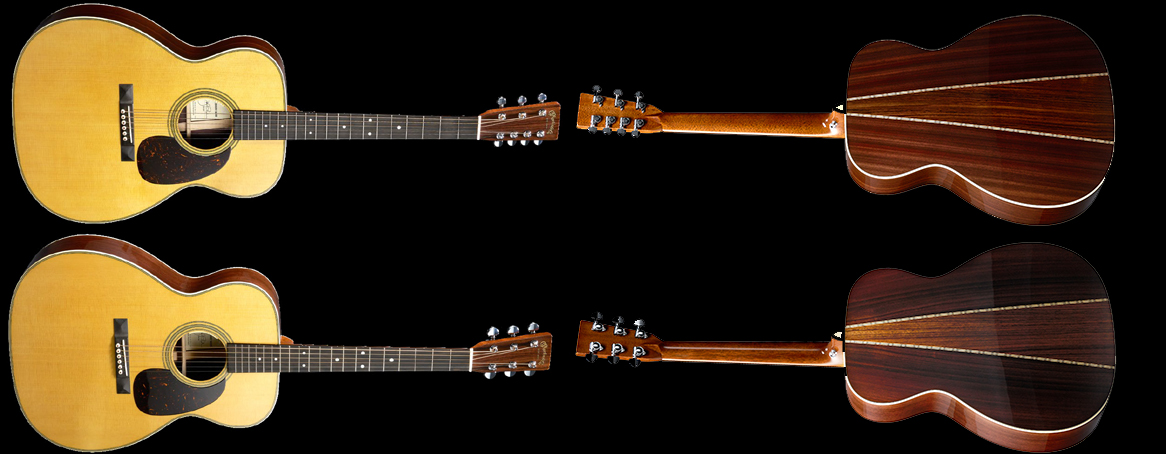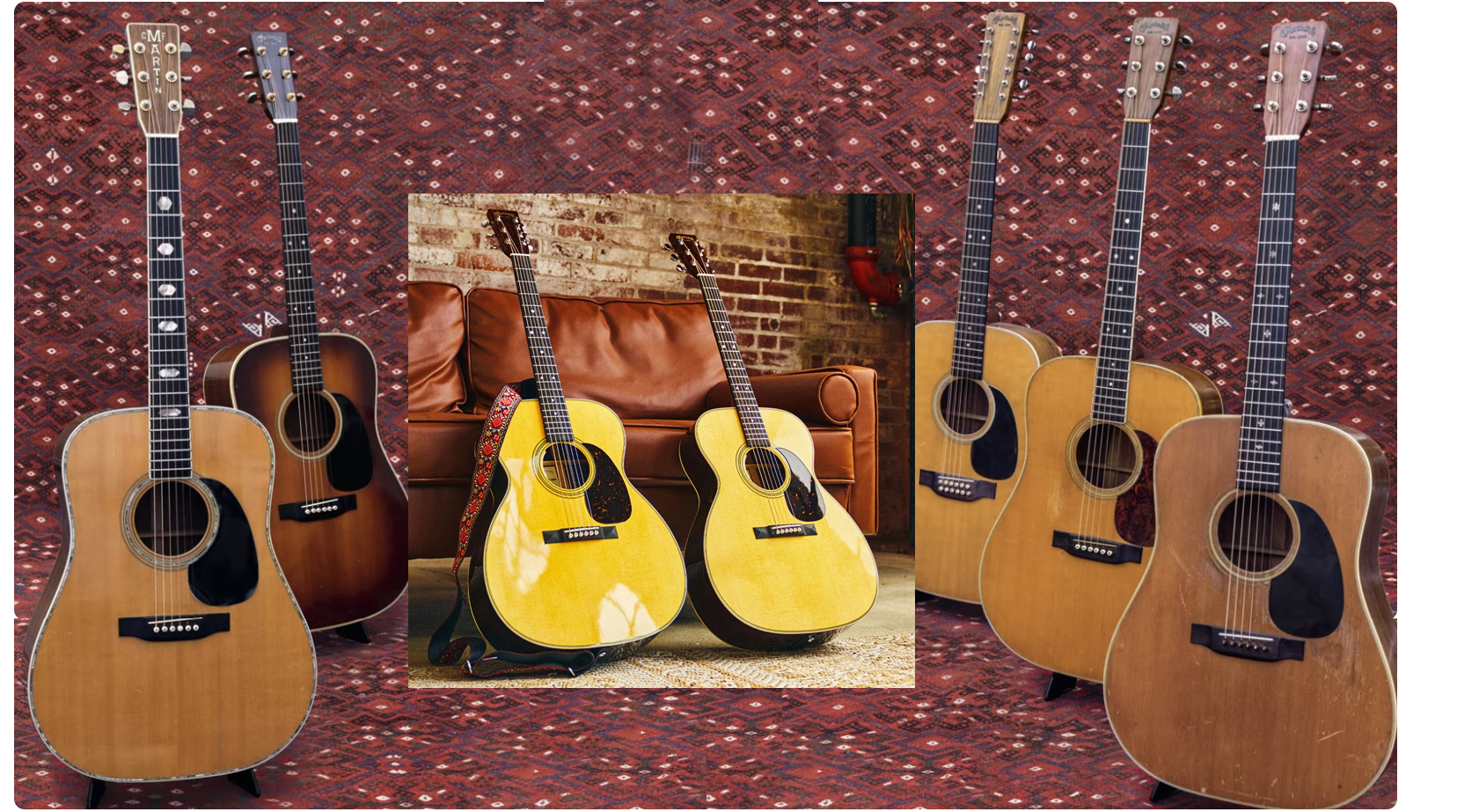Martin Guitar Makes Ms for Marr, Johnny Marr that is!
Tonesmith of the Smiths honored with a 7-string and 6-string artist edition
Specs of the Martin M7 Johnny Marr and M6 Johnny Marr models include a Grand Auditorium (0000) body size, all solid tonewoods throughout, including a premium grade spruce top with Antique toner, scalloped 5/16″ bracing; premium grade Indian rosewood sides and 3-piece back; tropical American mahogany neck with Full Thickness profile; ebony fingerboard with 1-11/16″ width at the bone nut and 2-18″ at the 12th fret, Style 28 mother-of-pearl fret markers; ebony straight pyramid bridge with bone drop-in saddle and red dot bridge pins; Antique white body binding; chrome enclosed tuning machines; LR Baggs Anthem electronics; handmade Souldier strap.
“In an amplified performance for a big venue, an M can provide plenty of punch from a well-balanced voice without the tricky feedback issues of a large guitar with a deeper body, like a traditional Dreadnought.”
M for Marrvelous
The Martin M7 Johnny Marr is a Grand AuditoriuM size 7-string acoustic guitar with onboard electronics designed with and for Johnny Marr, guitarist for the post-punk rock band the Smiths. The M7 is augmented with an unwound high octave G string that has its own tuning peg, but shares the same bridge pin as the wound G string. The M6 is a 6-string version of essentially the same guitar.
While known as an electric guitarist with a voracious appetite for and fleeting love affairs with axes of many makes and models, Johnny Marr has also made great use of acoustic guitars. Many of the well-loved songs from the 1980s hey day of the Smiths often weave electric and acoustic guitars together, or use energetic acoustic guitar chord progressions as the rhythmic backbone on songs like “Big Mouth Strikes Again,” from the critically acclaimed album The Queen is Dead (1986), one of Rolling Stone’s 500 Greatest Albums of All Time. He has performed with many acoustics from different makers, but many of the Smiths’ records were recorded on a Martin.
(click to enlarge)
Blending Styles
These new Martin custom artist signature models appear to draw their aesthetic appointments from two of his favorite acoustics. The 1971 D-28 that was a frequent choice as a Smiths studio guitar, and the D-35 he has turned to over and over in more modern times. But unlike those big dreadnoughts, these new signature models are Ms, which have the same depth as a 000 but a wide 16″ bottom bout. But there is no denying the guitar has as much in common the Martin M-36. Plus it has some unique features, like the Antique toner on the high-quality spruce top, and the absence of the stark bright white plies in the top trim and sound hole rosette of Standard Series Martins.
Standing for Grand Auditorium, the M size is sometimes referred to as the 0000, since it bears a close resemblance to the 000 and 00 Martin models and is essentially the next step up in body size. In an amplified performance for a big venue, an M can provide plenty of punch from a well-balanced voice without the tricky feedback issues of a large guitar with a deeper body, like a traditional Dreadnought. Many players also find the M is more comfortable when playing sitting down.
The Martin Ms first appeared in the 1970s, using body molds from the 1930s Size F archtop Jazz guitars, but made with a flat top and bracing like other Martins made at that time. Like the M-36 and the D-35, these new Marr models have an attractive three piece back with book matched outer panels and separated by a center wedge with contrasting grain. They also feature enclosed tuning machines and the Full Thickness neck profile, fingerboard geometry, and string spacing of the 1970s Martins.
Unlike most modern Martins, the M7 and M6 Johnny Marr models do not have a belly bridge, but a straight bridge with decorative pyramids carved at either side, like Martins made before 1930. Combined with red dot bridge pins and the Antique toner on the gorgeous spruce top, and the art deco mother-of-pearl domino dots on the fingerboard, and the fabulous faux tortoise shell pickguard, these new guitars look like they could have been some previously unknown vintage Martin from long ago.
The tonewoods are primo to the max! Beautiful Indian rosewood has nice color contrast and subtly complex grain, while the spruce tops have very straight long grain and luscious cross grain. Today’s Martins spec’d as “spruce” can be Sitka or its natural hybrid cousin Lutz spruce, which grow in the same Pacific Northwest forests and are virtually interchangeable in looks and tone.
(click to enlarge)
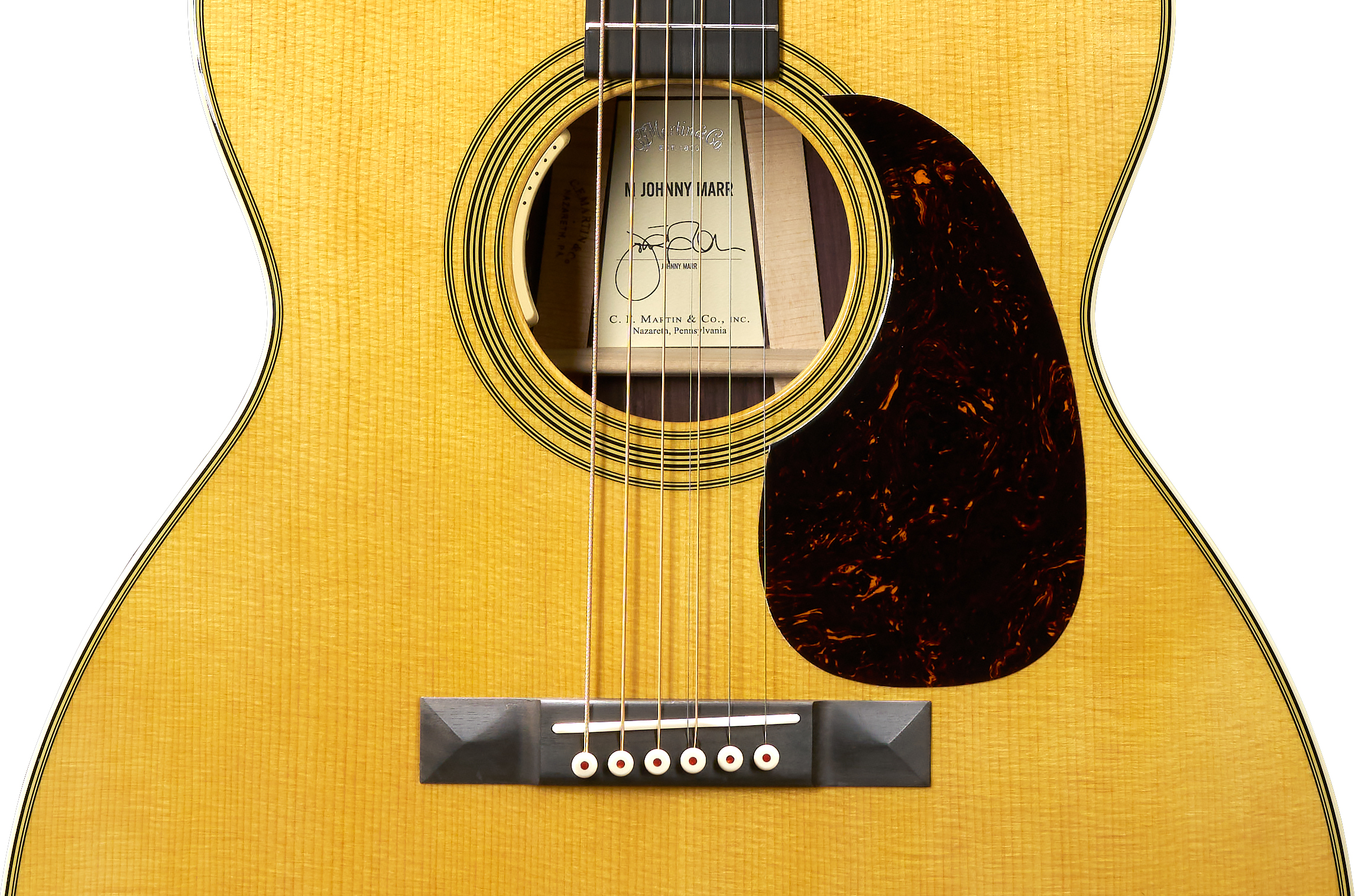 |
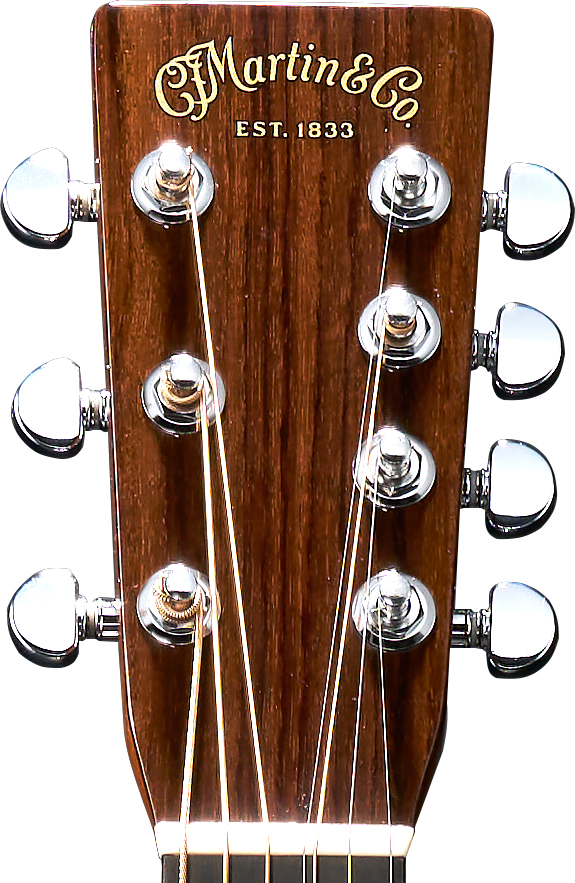 |
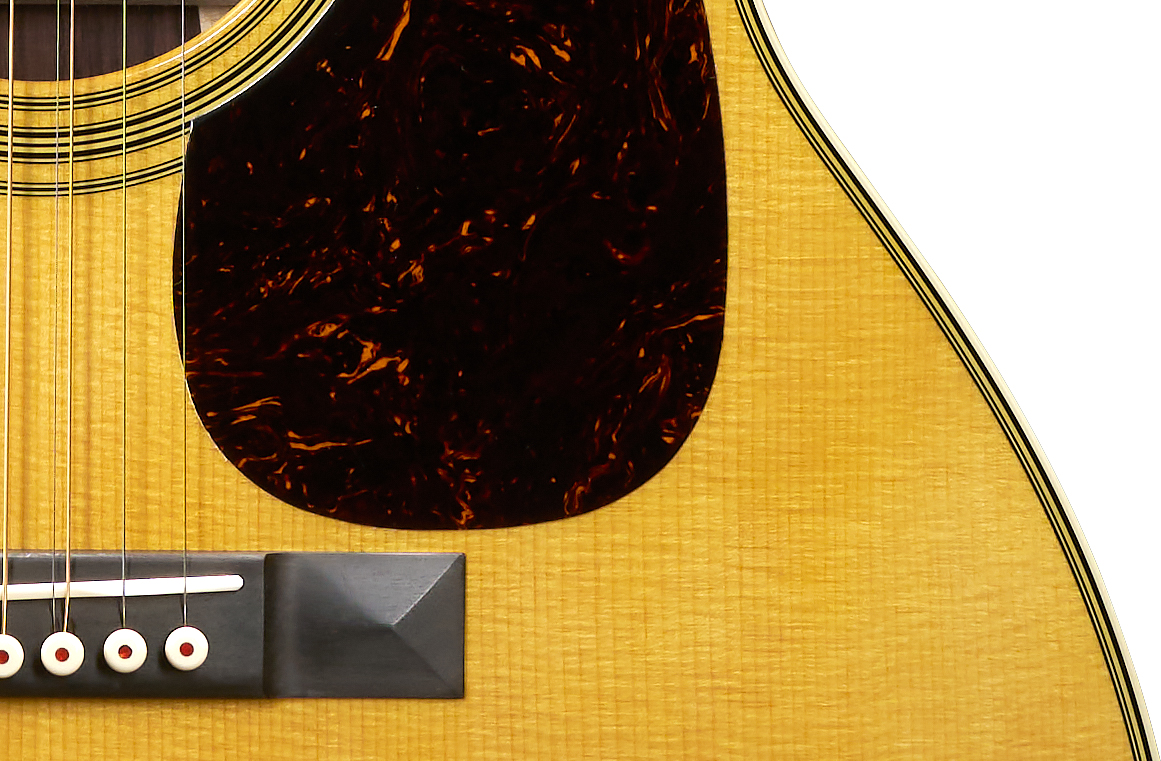 |
The 7-String Ring
Traditional 7-string guitars, often found in the Jazz word, are typically electric guitars, and the extra string is added to the bass side of the voice, in a lower tone than the low E string. In this case, it is an acoustic guitar and the unwound G string sits on the D string side of the wound G, just like the HD-7 Roger McGuinn model, which introduced this unusual configuration in 2007.
Just like McGuinn, Johnny Marr had a long-lived affection for the jingling tone of 12-string guitars. And like McGuinn, Marr owned and loved the Rickenbacker 360 model. But, in Marr’s own words, 12-strings require a lot of extra effort to maintain and keep in tune, so he ceased to use them after a while. Martin’s unique 7-string design brings back a lot of that Rickenbacker jingly jangle without the need for a wider fingerboard and finicky tuning of a 12-string guitar.
The Ric 12-strings are different because of that unusual placement of the octave string. Most 12-strings have it near the unwound B string rather than the wound D string. And that extra something that came from this configuration first captured the heart of George Harrison of the Beatles, when one of the first Ric 12s was sent to the Fab Four to see if they would like to be beta testers. Roger McGuinn and David Crosby saw the Beatles in concert in San Francisco and had to find out what exotic siren of an instrument Harrison was playing on numbers like “A Hard Day’s Night.” The rest is history, as McGuinn’s 12 string Ric on the Byrd’s albums had a similar effect on countless guitarists.
In the case of Johnny Marr, he often played a six-string Rickenbacker 330, which has its own jangling voice. So, he acquired the 12-string version. And now he has these new acoustic-electric Martins that give him similar tonal options, without all those extra strings to deal with.
Marr has performed and recorded with several Martins over his long career. As the master musician put it in his Mancunian accent, “Martins were always the guitar around the house. I soon as I was able to get one, I got one.” Here are pictured just a few, including the Smiths era D-28, D-28 Sunburst, D-35, and D-12-28, the two new custom artist editons.
Marr said that he had an inspiring talk with Fred Greene, Vice President of Product Management at C. F. Martin & Co., who had taken over designing signature models with the true superstar artists after the retirement of Dick Boak. Marr explained what he liked about his many different Martins, large and small. He asked about various specifications and if they could be combined together into one guitar. This included the three piece back of his D-35 and also the possibility of the 7-string design withe octave G string, which he had read about previously.
The prototype of the M7 arrived just in time for Marr to use it at a performance in his home city of Manchester in front of a live orchestra. “I already played with a sunburst D-28 the night before, on a solo song with the orchestra coming in at the end. On Day Two, this guitar arrived, the prototype, I thought, ‘Do I dare use it with the orchestra?” And anyway, I used it and just brought out a dimension to that performance that I was just so excited about!”
As a trailblazer of modern rock n roll, Johnny Marr is one of the most influential guitarists from the 1980s onward with a devoted fan base including many gearheads who went onto weave their own acoustic guitar sound into their rock n roll. Perhaps they will be inspired to purchase an M7 Johnny Marr for themselves. While Johnny Marr continues to rock out with his many electric guitars, he is clearly enjoying performing with his new Martin Custom Artist Editions. I cannot wait to see one in person and will share my first hand and first ear opinion once that happens.
And that is one man’s word on the Martin M7 and M6 Johnny Marr Custom Artist Editions – $4,999
~
And listen to some classic Smiths while checking out the photo album for the Martin M7 and M6 Johnny Marr models found HERE
Martin M7 Johnny Marr Spec Sheet HERE
Martin M6 Johnny Marr Spec Sheet HERE
